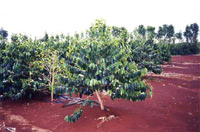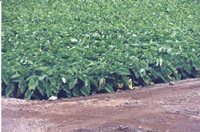Haleiwa
 Haleiwa and Surrounding Area
Haleiwa and Surrounding Area
Haleiwa is a rustic seaside town. The wooden buildings offer many treasures from surf and clothing shops to shave ice stands. You’ll find several restaurants, snack bars, North Shore Marketplace which houses the North Shore Surf and Cultural Museum and marine life artist, Wyland’s gallery.
From the late 1800s to the mid 1900s, the O’ahu Railway & Land (OR&L) Company’s track extended from Honolulu along the leeward side of the island, then around Ka’ena Point, to Kahuku. For passengers willing to pay a little extra, the round trip was a mini-vacation, with a night at the elegant Haleiwa Hotel, which was built in 1899, as a restful interlude between scenic rail journeys.
 Waialua Coffee Fields. New over the past ten years or so, are the Waialua Coffee Field along the roadside before getting to the Haleiwa area. With the dying of the sugar and pineapple industries, this “new” agricultural product is being introduced to the area. The coffee fields can be seen along both sides of the road.
Waialua Coffee Fields. New over the past ten years or so, are the Waialua Coffee Field along the roadside before getting to the Haleiwa area. With the dying of the sugar and pineapple industries, this “new” agricultural product is being introduced to the area. The coffee fields can be seen along both sides of the road.
 Taro Ponds. Just before Haleiwa, it’s very hard to see from a car but, just off both sides of this bridge is a splendid example of taro growing.
Taro Ponds. Just before Haleiwa, it’s very hard to see from a car but, just off both sides of this bridge is a splendid example of taro growing.
Poi, the Hawaiians’ staple food, is manufactured by machinery today. In the old days, it was all made by hand. Poi is made from the starchy root of the taro plant. All parts of the plant are eaten. The lū’au (taro leaves) are edible and quite delicious. Modern Hawaiian feasts are also called lū’au, so named because of the taro tops that are always served. There are more than 300 kinds of taro known in the Islands, some varieties more favored than others.
Because of its importance as a food in ancient Hawai’i and even today, it is a favored food, not only of Hawaiians but of other ethnic groups who have been raised in the Islands. The ancient Hawaiians used the taro as an illustration in many of their sayings of wisdom. “I maika’a ke kalo i ka ‘ohā”, or “Parents are judged by the behavior of their children”.
Haleiwa and beyond.
This has been a short overview of what’s to be found at and around Haleiwa. Next we’ll visit the Waimea Valley and Bay Beach area.